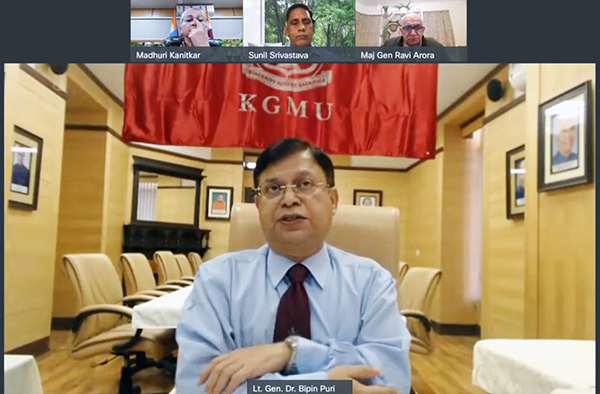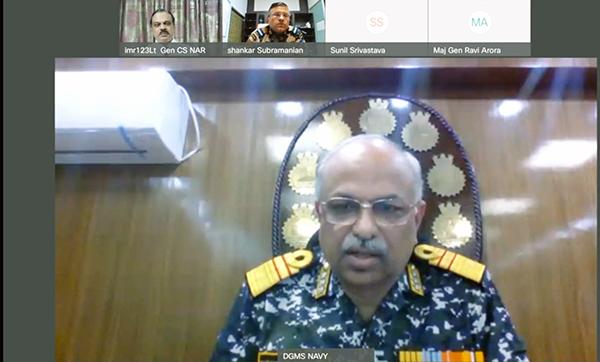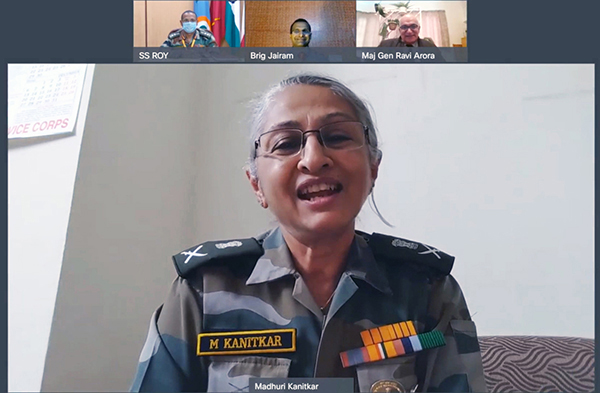A webinar & virtual expo was organized on 22-23 Oct 2021 by Centre for Joint Warfare Studies and Indian Military Review on www.showcase.imrmedia.in
COVID-19 is an unprecedented, worldwide pandemic that has been compared to the Second War and 1918 Spanish Flu in terms of the impact on human behaviour. Latest technologies for healthcare are playing a crucial role in keeping our society functional in times of lockdowns and quarantines and augmenting the medical support to the Armed Forces of India during pandemic times. The main focus related to COVID-19 was on three medical activities: diagnaosis, surveillance and prevention. Digital healthcare technologies such as in Telemedicine, Artificial Intelligence, Virtual Reality/ Augmented Reality and Robotics are the latest developments in this field and the Armed Forces and healthcare workers must leverage these.
Introductory Session
Recently Indian government launched Digital Health Mission to address some of the major challenges in terms of the health, infrastructure, health records, pharmacy services etc. Cloud computing in healthcare industry presents the possibility of military healthcare to synergise and coordinate these activities and technologies. Role of technology in healthcare includes preventive, promotive, curative and rehabilitative to incl EHR, diagnostics, reaching the unreached through telemedicine, wearable devices and monitoring systems, using AI algorithms to reduce errors and combat medical care. Biggest problem is our systems of education, research and healthcare. Telemedicine and remote medical care are possible ways of dealing with the situation wherein evacuation is not possible, especially when moving the casualties by road in bad weather conditions and in areas like Siachen Sector North.
In the first session, the Opening Address was given by Lt Gen Sunil Srivastava, Director CENJOWS. The Inaugural Address was given by Lt Gen Bipin Puri, Former DGAFMS and Vice Chancellor of King George Medical University. The Keynote Address was given by Lt Gen Madhuri Kanitkar, DCIDS (Medical), HQ Integrated Defence Staff.


COVID-19 and Novel Initiatives
In the second session on Covid-19 and Novel Initiatives, under the chairmanship of Air Marshal (Dr) Pawan Kapoor, Former DGMS (Air), the Keynote Address was delivered by Lt Gen Daljit Singh, Director General Medical Services (Army). Gp Capt TVSVGK Tilak, Professor (Medicine) & Medical Oncologist, AFMC, spoke on “Covid-19 care – Initiatives taken by the Armed Forces” and Mr Dilip Patil, Founder Director of Trivector Group spoke on solutions provided by his company.
The Nation’s health nearly infrastructure collapsed during the COVID pandemic. Virus has impacted almost 243 Million people across the globe with almost around 4.95 million deaths. The Armed Forces, mainly Medical Services have been glittering examples of taking up the challenges of COVID pandemic. AFMS came together to support the initiative of diagnostics, especially point of care devices and by reaching the unreached through telemedicine.
Remote Health Monitoring
In the third session on Remote Health Care, under the chairmanship of Lt Gen Anup Banerji, Former Director General Armed Forces Medical Services, the Keynote Address was delivered by Lt Gen Sanjay M Londhe, Former Director General Dental Services. Maj Gen Aftab Alam, Asst Chief of Integrated Defence Staff (Medical) spoke on “Remote Health Monitoring Technologies.”
Never before has remote monitoring gained so much relevance as during the pandemic. Large number of cases, risks of infections to the health care workers and non-availability of beds, led to reliance on remote monitoring. Remote Health Monitoring techniques can also be used for patients with neurological diseases, Alzheimer’s/ Parkinson diseases, cardio problems, diabetes etc by using gadgets/ sensors ie smart watch, smart vest etc. By predicting hemorrhage, through remote monitoring, the life of a soldier can be saved, which is a major cause of loss of life in combat conditions. For oral monitoring, the main advantage of connectivity is that the person can be at home, which can improve the people’s care at home, reduced chair time and visits. This will allow more efficient use of clinical resources, better screening and diagnosis.
Smart and Connected Healthcare Enabled by IOT
In the fourth session on Smart and Connected Healthcare Enabled by IOT under the chairman: Lt Gen CS Narayanan, Former Dy Chief of Integrated Defence Staff (Medical), the Keynote Address was delivered by Surg V Adm N Chawla, Director General Medical Services (Navy). Air Cmde Shankar Subramanian, Air Cmde AFMS (Planning & Training), Dte Gen of Medical Services spoke on “Smart and Connected Healthcare Enabled by IOT.”


Internet of things, big data, cloud computing and artificial intelligence have revolutionized health care making it more efficient, more convenient and more personalized beyond smart watches. Embedded, implantable or ingestible sensors can monitor everything be it cardiac arrest, baby’s heartbeat etc and they can be programmed to administer medication. They can predict health trends across the cultures and countries. AI is used in patient care, research and administration and logistics. AI/ IoT are here to stay and we need to scale up the equipment so that we can use these technologies.
Medicare Under Special Conditions
In the last session on Medicare Under Special Conditions, under the chairmanship of Maj Gen Ravi Arora, Chief Editor Indian military Review, Col SS Roy, Col (CBRN), HQ Integrated Defence Staff spoke on “Medical care of CBRN casualties” and Brig A Jairam, Prof of Nephrology, St John’s Medical College, Bengaluru, spoke on “Advances in High Altitude and Extreme Cold Climate Areas.”
The threat of CBRNe casualties is real as these weapons are being used worldwide be it Chechnya, Beirut, Tokyo, etc. CBRNe casualties can be chemical casualties, biological casualties, radiological casualties, nuclear casualties or a combined casualties, ie, chemical, biological or radiological with concurrent traumatic injury. There could be psychological casualties in which the patient has anxiety, stress, Post Traumatic Stress Disorder (PTSD), etc. As far as high altitude and cold climate areas are concerned, problems of chill blain, frostbite, HAPO exists. Understanding high altitude physiology is very important to deal with HAPO, AMC/HACE and acclimatization. Diamox assisted rapid acclimatization is feasible.
The Closing Remarks were given by Lt Gen Madhuri Kanitkar, DCIDS (Medical), HQ Integrated Defence Staff. The Vote of Thanks was given by Maj Gen Ravi Arora.
Challenges
Certain challenges which were highlighted in the webinar are elucidated below:-
(a) Education. Studies are going on in each Service how to incorporate new technology in medicine. However, impact of Tri Services optimization for theatre led integration is need of the hour.
(b) COVID Hospitals. Collaboration with other Govt agencies and Private stakeholders, infrastructural shortcomings like shortages of beds, House Keeping Staff and crowd management, workplace ergonomics for staff ie doctors, nursing attendant, nurse etc and integration of protocols and SOPs with the civilians.
(c) Teledentistry. Acceptance of teledentistry by dentists and patients and resolution of legal issues remains a challenge.
(d) Monitoring. Accuracy of data and informational integrity, intentional/ unintentional wrong data entry and more importantly data privacy/ cyber security incl service attacks. The most common defense against denial of service attacks is redundancy, but in a healthcare environment, it may be difficult to provide this defense because many of these monitoring devices are deeply embedded into critical life care systems.
(e) Patient Care. Patient does not have all the information about doctors. Hence, motivation/ willingness of the patient is most important for effective use of the technology.
(f) Medical Records. Medical Records of Armed Forces are stored in multiple formats, both paper and computer. The data of PME and various physicians’ opinions is collected in a decentralized manner and organized poorly. Treating physicians don’t have access to patient medical history hence there is a need to have the Electronic Health Records (EHR).
(g) Manpower Issues. COVID pandemic highlighted the shortcomings of manpower, both in quantity and quality. Manpower issues make it hard to handle data, create time pressures and pressure of EHR.
(h) Ownership and Accountability. Data access, backup, data storage, data recovery etc are major problems which the armed forces have to deal with. Accountability of health care provider, standardisation of data, data exchanges and ownership of the health care data needs to be institutionalized and an elaborate and formal policy on the same must be evolved.
(j) Costs. Interoperability amongst multiple components and recording continuous data of the patient requires more people, which will result in high costs.
(k) Portable Devices. Portable devices should be understandable, trust worthy and should not get disturbed in the battle field conditions.
(l) Connectivity Issues. Connectivity issues will definitely increase the digital divide between the haves and the have-nots and particularly in the field of health care.
(m) Privacy Issues. In countries like South Korea, they were monitoring COVID patients almost continuously on a 24 by seven basis through smartphones. Such situations create privacy issues.
(n) Problem of Nurses. Nurses spend 70% of the time, filling 45 to 65 registers/ databases on a daily basis and 30% time is being spent on patient care. This leaves the nurses and the patient deeply dissatisfied.
(o) CBRNe Casualties. Against the requirement of huge logistics support for evacuation and management of casualties, there is no trained manpower, decontamination of casualties, non-availability of commercial facility for production of CBRNe equipmenpts/ drugs, no definitive antidote treatment, no hospitals which are geared up CBRNe casualties. Most of the labs are not capable of detecting biological agents/ toxins.
(p) High Altitude Areas. Prolonged deployment (because of Chinese intrusion) in Ladakh sector of 6 months or more has not been studied. The troops may have to stay for two years and this is not given in the AO 110/80. Another problem is thrombosis in the brain, heart attack, stroke etc which is happening to young soldiers in high altitude.
(q) Casualty Evacuation. Casualty evacuation is always a challenge in high altitude and is a lifeline in high altitude.
(r) Army Aviation Challenges in High Altitude Areas. Lying patient cannot be carried in Cheetah/ Chetak, helipads with ALH capability are limited in forward locations.
Recommendations
Certain recommendations are given below:-
(a) Genomics. The rising focus on developing genomics, proteomics and bioinformatics will be the next step forward and we must, like all other superpowers, focus some of our resources on research in this area.
(b) Research. Develop a Research Wing within the AFMS for military medicines. Our research needs to be very focused and National Digital Health Mission is great step towards for health issues.
(c) Brain Storming Sessions. Brain storming sessions at each level to identify gaps and conduct focused research along with the local commanders.
(d) Collaborate. Collaborate with the Industry for implementing technology in a time bound manner.
(e) EHR. Electronic Health Records will open new opportunities for healthcare professionals and the patients.EHR is moving at a very slow pace but this will have to be at a disruptive pace. We need to move rapidly towards EHR with a top-down approach.
(f) Unconventional Warfare. To be prepared for unconventional warfare ie CBRNe warfare, facilities and equipment need to be scaled up.
(g) Mental Wellbeing. Mental wellbeing needs to be considered for rehabilitation. Hence, National Digital Wellness Platform ie MANAS (Mental Health And Augmentation System) will be launched by Scientific Advisor, in collaboration with AFMC Pune, C-DAC Bengaluru and NIMHANS, Bengaluru.
(h) Education. The feedback system for education must be developed to rapidly evolve the curriculum for any upcoming technologies and training all healthcare workers to be comfortable using them.
(j) Interoperability. Medical services of armed forces ie Army, Airforce & Navy needs to be integrated. Defence Digital Health Mission has made progress in the last year, and the study report is available in NHA. They are offering us the complete software package and the system will be a part of the same cloud and that the system will be secure.
(k) Software. We are developing indigenous software, iOS and android version is ready. It is at the beta stage.
(l) Technical Capability of Healthcare Workers. We need to improve the technical capability of our health care workers.
(m) Emergency Powers. During the COVID times emergency powers in DFPDS were given to Indian Armed Forces for procurement as a result PPE, Ventilators, Fumigation Machines, Mobile Oxygen Systems, Oxygen Generations plants etc were procured from indigenous vendors and also vendors from various countries incl New Zealand, Germany etc. These should be enhanced/ reviewed.
(n) Nano Strike Technology. Nano Strike utilizes a comprehensive range of physical concurrent pathogen inactivation processes, working in unision at the nanosecond level, to dis-infect the air. As these processes happen simultaneously, many millions times per second, it seems to the human eye that a virus, bacteria or fungi is obliterated in one deadly strike. Novaerus Dielectric Barrier Discharge (DBD) plasma differentiation has been tested and proven effective. The machine costs in the range approximately is Rs 2 lakhs to 10 lakhs, for a 400 sq ft room.
(o) Teledentistry. It uses a Live Video and it facilitates dental care, guidance, education or treatment. It has proved to be beneficial for remote dental screening, diagnosis, consultation and proposing treatment.
(p) Internet of Things. It uses sensors and software for the purpose of collecting and exchanging data, IoMT and IoDT etc. This data could be used in eventual risk assessment and research. This has revolutionised healthcare management via remote monitoring.
(q) Natural Language Processing. We used to get 300 patients in OPD and they used to ask hundred queries which are extremely personal in nature. Hence, we identified about 100 common questions which are in the patient’s mind, made a video, converting to the Indian languages. By using the Natural Language Processing, the algorithm would choose the most appropriate video, which is likely to answer the questions of the patient.
(r) Problem of Nurses. Use conversational, artificial intelligence in which a tab is given to nurses and she keeps a small checklist to ask the patient and she uses the tab to enter data through voice and the records are maintained automatically.
(s) Collaborate with the Industry. IoT based/ AI based algorithm by which we are able to connect all these devices, hence we need to collaborate with the industry for all these technologies.
(t) Benefits of Remote. Patient Monitoring. Benefits incl the personalized and detailed health information to the care provider, faster access of health services to the patient, enabling early detection of deterioration, reducing emergency visits/ hospitalization and more importantly reducing load on overburdened hospitals and clinics.
(u) Indigenous Solutions. We must procure the technology from an Indian vendor, not Chinese and all components must be indigenous. We must encrypt that data so that it cannot be used by anybody else. Standardisation for interoperability so that the two systems to communicate and share services with each other at the right time. We must have a communication protocol which the system follows. As regards the ethical issues, we must have consent as to who can see the data, with whom he shares the data and the device protocols should be there.
(v) CBRNe Casualties. Est robust surveillance system to detect bio and chem agent, BSL-III Labs should be est, govt should designate more hospitals for CBRNe Cas, educate public about basic CBRNe survival drills, and ensure commercial production of CBRNe eqpts/ drugs and introduce basic CBRNe curriculum at Sr Sec School/ Colleges.
(w) High Altitude Areas.
(i) Medicines. Acetazolamide (Diamox)/ Dexamethasone tablets for prevention and treatment of AMS. For preventing cold injuries, Alocalie Aloe Vera Cream (50%) with Vit E is a good cream.
(ii) Misc.
(aa) Stretcher. A Stretcher has been developed, through which you can actually drag the cas across. The suggestion is that it can be a electronic/ battery operated stretcher.
(ab) Hyperbaric Oxygen. Successful treatment of frost bite with hyperbaric oxygen treatment and hyperbaric oxygen chamber has been commissioned at Hunder near Siachen Glacier which will save a lot of limbs.
(ac) Hypertension. High altitude deployment has induced systemic hypertension in the past in which pulmonary artery undergoes contraction, becomes tight and causes pressure to go up in the pulmonary arteries. Such events require more studies in high altitude areas.
(ad) Out of Box Solutions. Eight hours of oxygen every day to a soldier. Each bed in the shelter has one such cylinder (jumbo cylinder of 24000L, catering for a week) which is refilled. It is used where there are shelters along with the electricity. The soldier has a peaceful sleep at night and he is ready for the next day. Study must be conducted on this project.
(x) Army Aviation. Helipads without ALH capability in forward locations needs to be upgraded to become ALH capable.
Conclusion
The webinar covered the entire spectrum of military medicines from the past, the present and the future. We need to close the gaps between education, research and health. Military medicine in India has done some of the pioneering work, be it discovery of malaria, to the original description of high altitude, pulmonary edema, etc. All these reports were prepared by military medicine specialists. Hence, we need to prepare a list ie pinpoint the things that came out from this discussion that need to be taken on by the leadership on a mission mode with delivery in mind.













